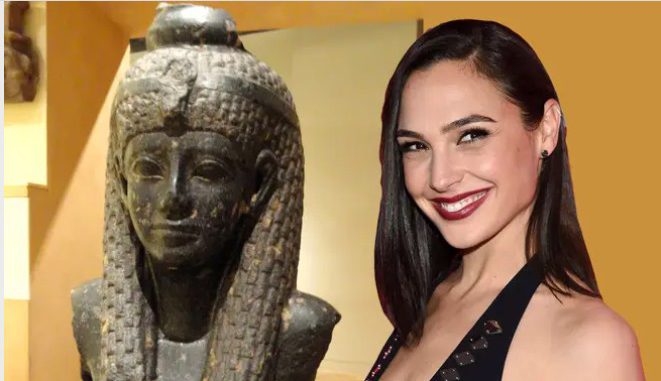
Gal Gadot like Cleopatra makes archaeological sense
DNA analysis has shown that the closest relatives of the Ancient Egyptians are the Levantines of today, so the Israeli Gal Gadot as Cleopatra is a pretty good match!
Following the announcement this week that Israeli actress Gal Gadot will play Egyptian Queen Cleopatra in a new film, social media has erupted in a fierce battle between advocates of greater diversity in film and its opponents.
Critics argue that a person of color should have been chosen for Cleopatra: an African, Arab or mixed race actress should have been given the role, but not Gadot, a Jewish woman of Eastern European origin.
The pro-Gadot camp replied that Cleopatra herself was apparently a white woman of Greek or Macedonian origin and that historical records show that the Arabs did not reach Egypt until centuries after Cleopatra’s death.
The queen of the first century BCE was a member of the Ptolemaic dynasty, a distant descendant of Ptolemy, the general who ruled Egypt after Alexander the Great conquered the country.
The most informed among Gadot’s critics have retorted that if Cleopatra was indeed the daughter and successor of King Ptolemy XII, her mother may have been of local African origin, meaning that the mistress of the famous Julius Caesar and Mark Anthony may have been of mixed heritage.
Greater cinematic diversity is a reasonable and noble cause, but the backlash is tinged with strong political and ideological nuances, and is accompanied by anti-Israeli and anti-Semitic abuses against Gal Gadot.
On the one hand, the latest controversy looks like a bad sequel to the one about whether Gadot should be considered white or a person of color, which erupted when she was chosen for Wonder Woman.
On the other hand, given that history and archaeology have been mobilized on both sides, this debate raises an interesting question: what do we really know about the ethnic origin of the ostensibly beautiful Cleopatra and the ancient Egyptians in general?
The short answer is: it’s complicated. Portraits of the queen on coins of the time do not help us clarify the question, although they paint a rather unflattering picture that suggests that Cleopatra’s legendary beauty was a later historical embellishment.
Some experts believe it is likely that Cleopatra may have had local Egyptian or African ancestry, but there is no clear evidence of that in any case.
The unusual case of an unknown mother
Officially known as Cleopatra VII Philopator, the future queen of Egypt was born in 70 or 69 BCE, the third of Ptolemy XII’s six children. The main problems in establishing her exact origin are that her tomb has never been found and her mother is unknown.
Some experts, such as the Yale classicist and author of “Cleopatra and Rome” Diana Kleiner, suspect that his mother was the first wife of Ptolemy XII, Cleopatra V Tryphaena.
This opens up a whole new possibility, as the origins of this Cleopatra are also unclear, although it has been suggested that she may have been the sister of Ptolemy.
This would not be surprising because the Hellenistic dynasty did not like to mingle with the local population and adopted the traditions of incestuous marriage and consanguinity that were common among previous generations of Pharaonic rulers .
Cleopatra VII herself first ascended the throne in 51 BCE as the wife of her younger brother Ptolemy XIII, whom she later eliminated in a power struggle with the support of Julius Caesar.
However, Cleopatra Tryphaena, died around the time of the birth of Cleopatra VII – and some experts have suggested that her mother may have been someone else, who remains unknown.
A sister murdered
The effort to prove that Cleopatra was a dark-skinned woman of mixed ancestry predates the brouhaha on Gadot’s casting. Perhaps the strongest case is presented by a 2009 BBC documentary about the figure of Arsinoe IV, Cleopatra’s younger sister and another of her rivals for the throne.
Arsinoe, who, with her brother, was a loser in the struggle for power with Cleopatra and her Roman allies, was first exiled to Ephesus, in present-day Turkey, and then assassinated on the orders of Mark Anthony in 41 BCE.
The researchers behind the documentary claimed that a tomb found at Ephesus in the 1920s was that of Arsinoe and that the measurements of the skull unearthed at that burial showed characteristics of African ancestry.
“He has this long head shape,” said forensic anthropologist Caroline Wilkinson at the time. “That’s what you see quite frequently in ancient Egyptians and black Africans. It could suggest a mixture of ancestry. In other words, if Arsinoe had African ancestry, his more famous sister did too,” the researchers postulated.
Leaving aside the fact that establishing anyone’s ancestry using skull measurements is a cumbersome and unreliable undertaking, many experts were skeptical about the conclusions of the documentary when it was first released.
Mary Beard, a renowned Oxford professor of classics, noted that there was little evidence to link this particular tomb of Ephesus to Arsinoe . Moreover, just as we do not know who Cleopatra’s mother was, we cannot be sure that the rival siblings were full-fledged sisters rather than daughters of Ptolemy XII of different women.
In any case, the argument that Cleopatra was of African descent is unfounded.
Historical ironies
Even if Cleopatra herself was a local woman and not an inbred Macedonian aristocrat, Gal Gadot would still be appropriate to play the role – perhaps even more so. Genetic analysis of 90 mummified remains of ancient Egyptians who lived between 1388 and 426 B.C.E. (just before the time of Ramses II and at the end of the Roman period, concluded that these people had affinities with people living in Israel in Jordan and the surrounding region, not modern Egyptians, which is NOT entirely surprising. It is known that in ancient times there was often massive immigration from the Levant, especially from Canaan, to Pharaonic Egypt.
Meanwhile, the same study revealed that today’s Egyptians have a much stronger African genetic component than their Pharaonic ancestors, which stems from an influx from sub-Saharan Africa long after the Roman period, in other words, long after Cleopatra’s life.
The study of the mummy’s DNA highlights the irony of the anti-Gadot campaign. Inadvertently, this is a very good argument for the Israeli actress to play the role of the Egyptian queen.
If indeed Cleopatra was a mixture of Greek and ancient Egyptian heritage and if we accept that ancestry should be a factor when choosing an actor to play a historical character (a big if) then someone of European and Levantine ancestry like Gadot seems like a good match. In fact, it seems to be the closest match we could get without actually bringing an ancient Egyptian pharaoh back to life.




Be the first to comment